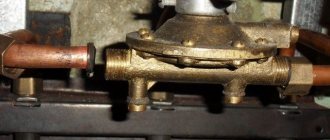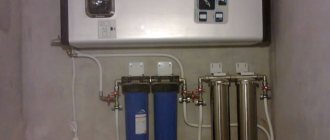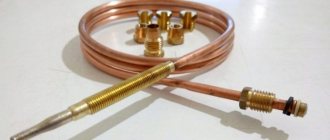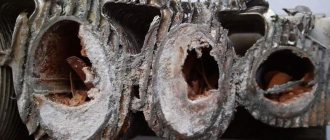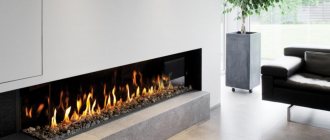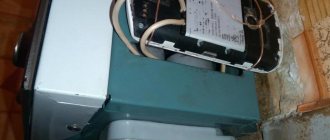If there is no hot water in your house or your hot water is constantly turned off, then life becomes completely uncomfortable. But this is not a reason to refuse a warm shower on a cool autumn evening, don’t you agree? This problem can be solved by installing a geyser, as many users do. But how does such a miniature water heater work and can it cope with its task?
We will talk about all this in detail in our publication - here we consider the principle of operation of a gas water heater and the diagram of its design. Attention is also focused on the main equipment malfunctions and ways to cope with them. The presented material is supplemented with visual illustrations, diagrams and videos.
Types of geysers
All geysers are divided into two large groups according to the method of supplying air - necessary to maintain the fuel combustion process. In order to correctly choose a good geyser for creating a hot water supply for an apartment or private house, you should familiarize yourself with the fundamental differences and design features of the models of each group.
Atmospheric
Water heaters with an open combustion chamber (atmospheric) take the air necessary for combustion directly from the room.
Atmospheric geyser
Removal of combustion products occurs due to the natural draft created between the combustion chamber and the chimney. Advantages:
- Simplicity of design;
- A lot of models in non-volatile versions;
- Affordable price.
The disadvantages include high requirements for the arrangement of the premises, the operation of the ventilation and chimney systems.
Turbocharged
Columns with a closed combustion chamber (turbocharged) use atmospheric air, which is supplied through the internal pipe of a coaxial chimney directly into the sealed combustion chamber by an air turbine.
Gas water heater with turbocharging
The combustion products are removed forcibly through the external space of the coaxial chimney.
Advantages:
- Low space requirements;
- Operational safety;
- Ease of installation of a smoke removal system.
Flaws:
- Energy dependence;
- High price;
- Higher noise level due to the operation of the blower fan.
Regardless of the design of the combustion chamber and smoke removal system, geysers can be flow-through or storage type.
Flow-through
A distinctive feature of flow-through models is the absence of a storage tank for water, as a result of which they have small dimensions. What type of geyser is best to choose to create a hot water supply for an apartment? The answer is obvious: flow-through models are ideal for installation in city apartments with connection to a central water supply system.
Flow model
Advantages:
- Instantly obtain hot water in the required volumes;
- Small dimensions and weight;
- Easy to use.
Disadvantages: low performance.
When choosing the performance of a flow-through model, you need to proceed from the number of water withdrawal points.
Cumulative
Storage units are equipped with a storage tank for water with a volume of 50-500 liters. The volume of the tank determines the dimensions of the device. The body of the device is reliably insulated to reduce heat loss from hot water.
Construction of a gas storage water heater
Advantages:
- There is always a supply of hot water;
- Thermal insulation of the tank allows you to retain heat for a long period.
Flaws:
- Large weight and dimensions;
- Long heating period.
Which gas water heater should you choose for a cottage or private home? Based on their design features, it is advisable to use storage-type gas water heaters to create a domestic hot water supply for a private home with a large number of water collection points.
Heat exchanger
Water is heated while it flows through the heat exchanger. It is a metal pipe installed above the burner. The shape of the heat exchanger in a gas water heater is special - a pipe with fins is laid in a snake at the bottom, then a sheet of metal is installed around it, on top of which the pipe is wound in a spiral. Water flowing through this long path is heated by the heated metal.
This is what a heat exchanger for a gas water heater looks like
Heat exchangers are made from galvanized steel (the most budget option), stainless steel and copper. The best in terms of efficient heat transfer are copper. They are the most economical, but also expensive. The most durable ones are stainless steel, but they are much worse at heat transfer. Which gas water heater is better in this case is up to you to decide. Choose the quality that is more important to you.
If you decide to buy a gas water heater with a copper heat exchanger, do not try to find a cheap model. In order to reduce the price, manufacturers use low-quality copper, and the tubes are also made with thin walls. Such a heat exchanger will serve the warranty period, and then problems will begin - a leak will appear.
If you remove the casing, you will see fistulas in the tubes through which water drips. They are located mostly on the outside of the pipe, exactly in the place where condensation forms. If the pipe is of normal thickness, this is not a problem, but it quickly corrodes thin walls. Such a heat exchanger with a leak does not need to be replaced (it costs about 1/3 of the total price), it can be soldered. You will need refractory solder with a melting point of about 200°C, a powerful soldering iron and soldering flux. The technology of work is usual - clean the damaged area to bare metal, degrease, tin, and solder.
Classification
Gas instantaneous water heaters are part of the residential hot water supply system. The device heats the water in the stream with the released heat from the burnt gas.
Depending on the operating conditions, flow-through gas heaters are divided into types.
According to the ignition method, the device can be automatic or with manual piezo ignition. The first option assumes that when the tap is opened, the burner turns on automatically (it also turns off). The fire is turned on by electronic ignition. There is no need to supervise the operation of the device. Manual piezo ignition is a connection using a button. Such a device must be installed in an accessible location.
Subsequent division is made taking into account the power of the device. Low power devices include 17-19 kW speakers; with an average power rating there will be a device of 22-24 kW; a high-power column is 28-30 kW. The more points of water consumption and the number of family members, the greater the power rating of the gas water heater.
The consistency of the temperature of the water in the tap depends on the type of burner of the device. They separate a burner with constant power, when with different water supplies the burner operates with the same power. Then, depending on the pressure, the temperature of the liquid in the tap will change. The modulation type burner adjusts to the water pressure in the water supply. Therefore, the temperature will be the same regardless of the liquid pressure.
The device is divided into a structure with smoke removal naturally. When gases are removed with traction. The second type of dispenser is turbocharged designs (chimneyless model). Combustion products are forced out using a fan built into the column design. It starts working from the first seconds of ignition of the burner.
Internal parts of the column, their purpose
Before looking inside the column, it should be clarified that modern gas flow models come in 2 types:
- With an open combustion chamber. The air necessary for gas combustion will flow through the viewing window or from below the structure without coercion, naturally from the room.
- With a closed combustion chamber type. They are called: turbocharged. The necessary air enters the combustion zone forcibly, using a fan.
This division is important to know, since the speakers are structurally different from each other. The device is installed on the wall
Water and gas pipes are connected to it
The device is installed on the wall. Water and gas pipes are connected to it.
A simple atmospheric water heating column consists of components and parts:
- light metal body;
- gas burner with igniter;
- finned heat exchanger with casing and copper coil;
- automatic sensor for adjusting combustion intensity;
- the safety valve is installed on the mechanical water unit;
- ignition system;
- The chimney is connected through a pipe located on the diffuser.
- combustion products accumulate in the diffuser. It has a traction sensor inside. Wires go from it to the gas valve;
- A flame presence sensor is also connected to the gas valve. It is located in the combustion zone;
- water and gas are supplied through the lower tubes. They end with fittings for connection.
In the photo, the atmospheric gas water heater is painted in detail.
Modern speakers are ignited by electrodes that can ignite gas with an electric discharge.
A gas water heater without a chimney (tared) differs from an atmospheric one, although they are similar in design:
- The turbocharged column has a modulation burner model. The combustion intensity changes automatically. Atmospheric - a manually controlled burner.
- To burn the flame, air is supplied by a fan. Its operation is controlled by an electronic unit.
- Ignition is carried out automatically. The system is powered by electricity.
- An important role is played by the water temperature control sensor, which is connected to the controller. It keeps the water heating at a certain level, for example 60 degrees.
The photo shows a turbocharged gas water heater, in which all functions are automated. The set temperature is reflected on the LCD display.
Unit design
Gas water heaters, regardless of the manufacturer, have similar components, the presence of which may differ slightly between different models. For example, we can consider the construction of the Neva gas water heater.
Device structure from the outside
The diagram of the gas water heater is shown in the figure below.
Gas water heater diagram
The front part and sides of the water heater are covered with a metal casing (1). There is an observation window (2) on the facade of the device for visual monitoring of the operation of the unit. Under the window there are regulators: a knob that regulates gas flow (3) and a water flow regulator (4). Between the handles there is an LCD display (5), which displays the temperature of the water supplied to the consumer.
At the very bottom of the device there are pipes for water supply and outlet, as well as for gas supply. On the right side of the water heater there is a pipe (6), to which cold water from the water supply is connected, and on the left, a pipe (7) is connected to drain the heated liquid. Next to it, but a little closer to the center, there is a pipe (8). A hose is connected to it, connecting the dispenser to the gas main, and in some situations, to a gas cylinder. At the very top of the water heater, there is a flange (9) for connecting the gas outlet pipe (chimney).
All elements of the unit are fixed to a metal base (10), which serves as the rear wall of the device. It has 2 holes for hanging the unit on the wall using brackets.
Internal structure of the unit
Now let's look at how the geyser works from the inside, with the outer casing removed. As mentioned above, pipes numbered 6, 7 and 8 are intended for connecting cold water, discharging heated water and connecting gas.
The water block of the unit (12) is connected to the water supply pipe (6). A rod (13) comes out of the water block, on which a handle is attached to adjust the water pressure. Below is a cylindrical part (14), which has a notch on the walls. It functions as a plug that can be removed to drain liquid from the device if repairs are required. The plug also has a safety valve that opens when there is excess pressure in the water supply.
In the center of the unit there is an electronic control unit (16). Wires are routed from it in different directions, going to various elements of the unit and sensors.
Column structure from the inside
On the left, symmetrically to the water block, there is a gas block (17). Both modules are assembled in such a way that they represent a single structure. From it, like from the water one, comes a rod (18) to adjust the gas supply. In the middle between the gas pipe and the control valve there is a valve (19) (electromagnetic).
There is also a microswitch (15) on the gas block, which is pressed by a special pusher when it is turned off. Above you can see the manifold (20), connected to the gas block using a pipe fitted with flanges. The manifold is attached to the body using 2 screws (21). The nozzles are located at the rear of the manifold. Through them, gas is supplied to the burner (22), which has 10 rows. A pair of elements are attached to the front of the collector, similar in appearance, but performing different roles. On the right is the spark plug (23), which ignites the burners, and on the left is the flame sensor (24).
Above the collector there is a copper heat exchanger (25). It just gives off the heat obtained from the combustion of gas to the water passing through it. A water unit (26) is connected to the heat exchanger on the right, and a pipe for discharging heated water (27) is connected to the left side. The heat exchange module is attached to the unit body using 2 screws (28). There are 2 sensors installed on the pipe for discharging heated water. The top one (29) protects the water heater from overheating, and the one below (30) serves as a thermometer. Wires go from it to the LCD display mounted on the casing of the unit.
At the top of the apparatus there is a device for removing waste combustion products (31). Thanks to a system of jumpers of different shapes, the flow of hot exhaust gases is directed towards the chimney channel. A draft sensor (32) is installed on the left, which is connected to the overheating sensor (29) via an electrical circuit. At the bottom of the water heater body there is a block (34) for 2 power elements (batteries). To fasten the outer casing of the device, there are places for screwing in screws (33) on both sides of the housing.
You may be interested in: how to repair a gas water heater.
How to check traction
This refers to open-type geysers. Advanced models include an automatic security system. If the traction disappears during use of the device or is completely absent, then it will not work.
However, you should not rely unconditionally on automatic systems. You need to be able to check for traction. For this purpose, gas service specialists have special measuring instruments that check the force of air movement.
The following methods are used for self-checking:
- Remove the part of the device that is on the left. Place a small strip of paper near the chimney. If there is air movement, the paper will be slightly sucked in.
- Light a match and place your hand next to the viewing window. It is located on the front panel. If the flame is sucked in, then there is draft.
Pros and cons of columns with electric ignition
Gas water heaters with electric ignition have the following advantages:
- ease of use - the user only needs to turn on the tap;
- fuel economy;
- high level of security.
Minuses:
- high price;
- the need for a supply of batteries.
Electric ignition is often equipped with devices with a closed combustion chamber, which are equipped with a coaxial chimney.
Note! Some models of geysers, in which electric ignition is powered by batteries, have a light indicator on the control panel that notifies you of the battery charge level.
Principle of operation
In general, the operating principle of geysers is quite simple:
- When gas burns, thermal energy is released;
- Thermal energy heats the heat exchanger. The latter is usually made of copper or special alloys with high thermal conductivity;
- A coil passes around the heat exchanger, also made of metal with high thermal conductivity, as a result of which it also quickly heats itself and heats the water;
- Hot water is supplied from the coil to the pipeline;
- Combustion products leave the combustion chamber and are discharged outside through the chimney.
Construction and operation of a gas water block. Separately, we should consider the design and operating principle of the gas water block. As I said above, the water block reacts to the water supply and ensures the start of the column.
Gearbox device
The main element of the water block is the gearbox, which is called the “toad”. Inside it there is a membrane with a rod. In modern columns, the water unit works as follows:
- When the tap is opened, the water flow passes through the reducer;
- Increased pressure forms in one of the reducer chambers, as a result of which the membrane (position 2 in the diagram above) bends and pushes out the plate. The plate, in turn, pushes the rod (position 1). It must be said that the rod pressure is about 50 kg;
- The water rod pushes the rod of the gas module, which is located opposite;
- A pusher connected to the rod acts on the switch plate, as a result of which electricity from the battery section enters the electronic control module section, and then into the ignition burner, where a spark is formed;
- At the same time, the rod presses the mechanical gas valve and gas begins to flow into the ignition system and burner. At the same time, an additional solenoid valve is also activated, which also ensures free passage of gas;
The igniter ensures ignition of the gas burner
- When a spark appears, the gas ignites in the igniter, after which the main burner lights up. In this case, the flame presence sensor sends a signal to the control unit, as a result of which the spark plug producing the spark is turned off;
- When the hot water is turned off, the pressure in the two chambers of the reducer is equalized, as a result of which the rod is pressed out. Accordingly, the gas valves are activated, and the gas supply to the burner is abruptly stopped.
Modern speakers also have a water temperature sensor. When the water heats up above the set temperature, it sends a signal to the control unit, which in turn shuts off the gas supply system. When the water cools down, the sensor is triggered again and the burner is ignited.
In simpler models, many sensors are missing, but in any case, the gas supply opens only after the water pressure in one of the reducer chambers increases. Therefore, if the water pressure is insufficient, the column will not turn on.
The principle of piezo ignition is based on the conversion of mechanical energy into an electrical discharge, which ignites the igniter
Ignition method. Currently, there are the following types of speaker ignition:
Manual. In this case, to ignite, you need to turn the handle of the column all the way, without pressing it, and then light the igniter with your own hands, for example, using matches. After igniting the igniter, you need to press down on the handle and turn it clockwise to turn on the gas supply to the burner. At the same time, the igniter will light the burner;
Lviv column with piezo ignition
With piezo ignition. In such dispensers, as in manual ones, gas is first supplied to the igniter. To light it, you need to press a special button, which will result in a spark. After igniting the pilot, you can open the gas supply to the burner. During the day, you don’t have to extinguish the igniter; therefore, the next time you turn on the column, you don’t need to press the button.
Column Oasis with automatic ignition system
Automatic. We discussed the operating principle of automatic ignition systems above. These speakers are the most convenient to use, however, they are the most expensive. This, in fact, is all the information about how a gas water heater works that I wanted to share with you.
If the hot water pressure drops, you need to disassemble and clean the reducer
Types of Electric Water Heaters
The most economical way to heat cold water is to use a gas water heater, but in most cases this heating device is simply impossible to install. Multi-storey buildings most often do not have special systems for removing natural gas combustion waste, and many private houses and summer cottages are not gasified. Therefore, in this case, the installation of electrical appliances to produce hot water has no alternative. All electric water heaters are divided into only two types: storage (boilers) and instantaneous. Below we will briefly look at the operating principle of each type separately.
- Electric storage water heater (boiler). This device is most often called a boiler. The device is a simple water tank with installed heating elements (heating elements) and electronic or mechanical control systems. The container itself is thermally insulated from the external environment, which allows significant energy savings. The operating principle of a storage water heater is static. The tank is filled with cold water and it is heated using heating elements. The entire process of heating and maintaining the required temperature occurs under the control of an automation unit.
- Flow-through electric water heating device. The operating principle of an instantaneous water heater is dynamic. This device does not have a cold water storage tank. The process of heating water with heating elements occurs in special pipes and coils with a constant flow of aqueous medium through these elements. As in storage systems, instantaneous water heaters implement the principle of mechanical or automatic control using an electronic unit. To quickly heat a strong flow of water to the required temperature, the flow-through electric heater must have sufficient power, which is a certain disadvantage.
These two types of electric water heaters may have different designs. There are devices with indirect heating, where thermal energy is transferred to water through an additional coolant in a heat exchange module. In this case, the heating elements heat up a special liquid, which, in turn, transfers heat to the cold water in the heat exchanger. In addition, not only heating elements, but also other devices, for example, infrared sources, can be used as heating elements.
But all these devices are much more expensive, so instantaneous and storage water heaters with direct heating of water by resistance heating elements, that is, heating elements, are mainly used. Below we will take a closer look at the device, operating principle, advantages and disadvantages of both types of electric water heating equipment. This will allow you to make the right choice of device for uninterrupted supply of hot water to your home, office or utility room.
Analysis of the most common installation errors
The most common mistake is installing a geyser in the bathroom. As a rule, this room does not have a window. It is especially dangerous to install speakers without a chimney. There are models of water heaters in which carbon monoxide exits through openings, and is removed from the room through a ventilation hole in the wall.
The second most common mistake is the desire to hide the device so that it does not visually stand out from the interior. Often a geyser is installed in a cabinet. This leads to disruption of the proper functioning of the gas water heater.
Even if a distance of 10 cm is maintained from the cabinet walls and there is no bottom bottom, the air flow will still be insufficient to cool the device. It will take longer to cool down, which will significantly shorten its service life.
The third mistake that often occurs is a mixed-up connection of the gas pipe in the column. This leads to water entering the gas pipeline. The liquid gets there through the gas column and then moves down through the pipes. This is how water enters the gas equipment of the neighbors below, completely disabling it.
Liquid removal is carried out by gas services. Once a source is discovered in the owner’s apartment, the gas will be turned off and a fine will be issued. This is what a gas shutoff order looks like
It is impossible to prevent GorGaz workers from performing a shutdown. In case of refusal, the police will be called, as people's lives are at risk.
Recommendations for maintenance and repair
All elements of the column structure are subject to destruction due to various factors. Any gas equipment requires regular maintenance. If defects are identified during maintenance work, they must be eliminated as quickly as possible. Of course, some repair work should be entrusted to a professional, but some can be done independently.
Dismantling and adjusting the gearbox
You must first turn off the fuel and water supplies. Only after this can you begin to carry out preventive or repair work. To remove the gearbox, you need to perform several steps:
- Water is drained from the heat exchanger;
- using an adjustable wrench, the gas and water pipelines are disconnected from the column;
- If no mistakes were made at the previous stages, the gearbox can be easily dismantled.
Depending on the model of the unit, changes may be made to its design. To avoid problems when dismantling the water reducer, you must first disconnect all pipes and parts that make the work difficult. The housing should be easy to remove; no physical effort is required.
To adjust the gearbox, you must use special bolts located on the back side of the unit. Most often, the unit is already prepared for operation at the factory and does not require additional configuration. It is not advisable to adjust the unit unless absolutely necessary.
Cleaning the water unit
This event must be held at least once every 12 calendar months. When unscrewing the fastening bolts located on the unit cover, you must be careful not to damage the folds. When the cover is removed, it is necessary not only to clean the internal space of the gearbox, but also to perform the following procedures:
- All solid residues from the bottom of the part must be removed, and the coarse water filter must also be rinsed.
- It is advisable to lubricate the rod with grease or castor oil.
- If you suspect that the gasket has lost its former elasticity, it also needs to be lubricated.
With regular maintenance of the unit, its service life can be significantly extended. Most often, the rod seal and membrane fail. The first element must be replaced once every 3 years, and the second - after the appearance of ruptures or microcracks. In addition, during intensive work the spring for returning the rod to its original position may break.
Having carefully studied the design and principle of operation of the gas water heater, you can carry out all preventive measures yourself. If you don’t have confidence in your own abilities, then you should turn to professionals for help. When working with the unit, you must strictly follow the instructions.
Speakers powered by gas cylinders
In country houses where there is no gas pipeline or problems with the power of the electrical network, a gas water heater powered by a gas cylinder will be a salvation.
A cylinder with a capacity of 50 liters of gas is enough for daily use of hot water with a minimum consumption of 3 people per month.
To comply with safety standards, you must make sure that the dispenser model is designed to use the type of gas with which the cylinder is filled. If the dispenser is to be re-equipped, then it is required to leave a mark on the dispenser with the re-configure number and the type of gas permitted for use.
There are standard indicators for work:
- the cylinder is used with a reducer with a stabilization pressure within 300 mm of water column;
- the minimum vapor phase capacity for a cylinder is 1 m3/hour;
- a hose used for working with gas equipment is 2.5 meters long, with an internal cross-section of 12 mm.
Review of popular models
A geyser that is characterized by high reliability and affordable cost is considered popular.
If the question is choosing a semi-turbocharged speaker, then you should pay attention to the Polish brand Termet. Large selection of models
Aquacomfort Turbo G19-03 has an affordable price and optimal parameters. The device is equipped with a burner with a power of 19.2 kW. The maximum flow rate of hot water at a temperature of 25°C is 11 l/min. Connection of main and bottled gas is available. The cost of a water heater is about 7 thousand rubles.
When choosing turbocharged water heating devices, you can choose the model range of the manufacturer BOSCH. The speakers are expensive, but reliable. The Therm 8000 S WTD 27 AME model is characterized by a maximum hot water flow rate of 25 °C - 27 l/min. Burner power – 45 kW. Cost – about 110 thousand rubles.
A turbocharged dispenser, taking into account the cost of installation and paperwork, will cost the consumer a lot. However, among gas flow-through heaters, a supercharged device comes first.
The principle of operation of a flow-through gas device for heating water
The principle of operation of a gas water heater can be briefly described as follows: open the hot water tap - the burner lights up, the water flow stops - the burner goes out. In more detail it happens like this:
When the tap is opened, water begins to move. The action of the flow triggers the water unit. The mechanism acts on the gas unit. The valve opens and gas is supplied to the burner, where it is ignited by the igniter.
- The water is heated in a heat exchanger. The liquid circulating through the coil is heated, after which it flows through the pipeline to the mixer.
- During combustion, air enters the chamber naturally through the technological openings of the casing and the viewing window. Exhaust gases escape through the chimney. Natural air circulation creates draft. If it is not there, the sensors give a signal to turn off the burner.
- When the water tap is closed, the water and gas units are activated. The gas supply will stop, followed by the burner going out.
Turbine-type geysers work similarly. The only difference is the method of supplying air inside the closed chamber. The blower fan is responsible for this function. The chimney and discharge pipeline are double-walled pipes. She is taken outside. Combustion products are removed through the internal channel, and clean air is supplied from the street through the external passage.
Troubleshooting water heating devices
Connection diagram of steel smoke exhaust pipes for a gas water heater.
When using geysers, some problems may occur.
Like any other equipment, water heating devices can also break down. Some breakdowns can only be repaired by people who have special clearances, skills, permits and work experience. But there are also problems that you can fix yourself.
The most common breakdown is that the column does not turn on. If the device has electronic ignition, then this problem can be solved by checking the batteries and replacing them if necessary. Typically, such malfunctions occur after a year of operation, since the batteries generally do not work longer.
Among the breakdowns, there is a case when the column does not heat the water or heats it only slightly. The reason for this may be a defect in the membrane located on the water unit, which stops responding to changes in pressure in the water supply system. If it does not stretch under the pressure of water, the gas valve may open slightly or will be closed. The main defects may be:
- salt deposits;
- cracks;
- clogging and so on.
To solve this problem, you need to disconnect the column from the gas supply, clean the water pressure unit and check the membranes.
If the internal components of the device are contaminated with dust and soot, then it may also stop functioning. In order to fix this problem, you need to remove the outer casing of the equipment and clean all internal parts with a vacuum cleaner.
Another problem when using a gas water heater may be that after turning on, the burner immediately goes out. The reason for this is a clogged ventilation duct. In modern water heating devices, special sensors are provided for this case, notifying a person about the lack of traction. The gas supply must be stopped immediately.
Features of operation
There are a number of provisions and rules according to which the use of gas equipment is permitted. Let's consider the basic requirements for open-type speakers:
- Do not start work in the absence of draft in the chimney or in the presence of reverse draft;
- It is not allowed to turn on and ignite without studying the operating instructions;
- For normal operation, natural ventilation is necessary (window, vent);
- It is prohibited to independently change the design of the equipment.
Dispensers with an open combustion chamber are most at risk of gas leakage. If you smell it, then:
- Close the valve;
- Open the windows and ventilate the room;
- Do not light a fire until the room is completely ventilated;
- Contact the repair service.
Before starting the appliance, check the presence of draft in the chimney.
How to properly check
There are two “folk” ways of checking:
- Take a piece of paper and hold it near the chimney or ventilation. If the leaf tightens, it means the shaft is working properly. If it falls, you need to clean the hole.
- Light a match and bring it to the viewing window. Does the flame deviate to the side? Then you can start the column. If it burns smoothly, check the chimney.
It also happens that everything is in order with the mine, but there is no traction. The room may not be ventilated, so there is no air flow for combustion.
How to turn on the water heater
Before turning on any equipment, there must be water in the heat exchanger. Therefore, you should first open the water valve.
Electric models:
- Insert batteries into the battery compartment;
- In some cases, you need to turn the power or temperature switch;
- Open the gas valve;
- Turn on the mixer on the hot position, which will ignite.
Semi-automatic devices:
- Start the fuel supply;
- Set the power and hold the piezo ignition button until the wick ignites;
- When you turn on the water, the burner will light up.
It is not difficult to launch modern technology. What about an old-style product?
Ignition of an obsolete type column
A device with manual ignition is considered obsolete. The design provides for constant burning of the wick and manual shutdown. Ignition occurs from a burning match, less often - using piezo ignition. These include: “Iskra KGI-56”, series L, GVA, VPG. They are equipped with a turn signal or lever to regulate the temperature.
The operating principle is the same as that of modern models. The only difference is in the features of turning on the heating. If this is your first time launching, then you should know that:
There must be a constant flow of air in the room with the column
This is important to keep the flame burning. Therefore, in kitchen doors there is a gap of 5 cm at the bottom
If plastic windows are installed, a ventilation valve is required; It is necessary to regularly check for traction; Check the condition of the gas valve. Open it and coat the joints with soapy water. If bubbles appear, there is a leak.
For ignition, it is more convenient to use long matches that can easily reach the igniter.
Launch of KGI-56
Turn the fuel and water valves. Now turn the left control all the way to the left. Hold down the solenoid valve button if the product has one. Continuing to press the button, ignite the igniter with a match. After that:
- Open the hot water faucet;
- To light the burner, turn the other knob to the left.
Done, you can go take a shower.
Switching on devices of type L, GVA, VPG
Start as with other types by supplying gas and water. Move the knob on the panel to the first position. Press the valve release button and hold a match to the igniter. Hold the button for another 10 seconds. Just as in the first case, turn on the tap and quickly turn the regulator to the maximum level. After ignition, you can start using it.
You can turn off the equipment by turning the lever until the wick goes out. It is advisable to do this at night and before leaving home.
Use your water heater correctly for long service life and your own safety. Once a year, carry out preventive inspections of the product, clean the parts from scale.
- https://avtonomnoeteplo.ru/vodonagrevateli/731-pravilno-vklyuchit-gazovuyu-kolonku.html
- https://oventilyacii.ru/otoplenie/kak-vklyuchit-gazovuyu-kolonku.html
- https://tehnofaq.ru/kak-pravilno-vklyuchit-gazovuyu-kolonku/
- https://teplo.guru/vodonagrevateli/kak-vklyuchit-gazovuyu-kolonku.html
- https://cosmo-frost.ru/gazovye-kolonki-i-kotly/ekspluataciya-gazovye-kolonki-i-kotly/kak-polzovatsya-gazovoj-kolonkoj-novoj-i-starogo-obrazca/
